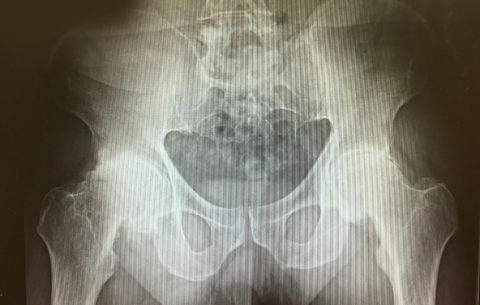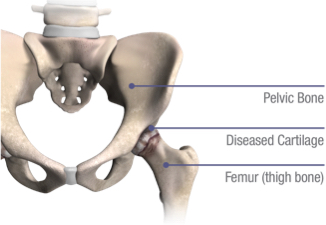What is Bilateral Total Hip Arthroplasty?
Bilateral total hip arthroplasty is a procedure in which both diseased hips are replaced. Dr. Stewart began performing bilateral total hip arthroplasties in 2015 for patients with severe osteoarthritis in both hips. Bilateral total hip arthroplasties allow patients to reduce the length of recovery in comparison to undergoing two consecutive hip replacements, which would need to be spaced out at least 6-12 weeks apart.
PAIN POINTS
What is Degenerative Joint Disease (DJD)?
Degenerative joint diseases (DJDs) are chronic conditions often resulting in pain and the loss of an active lifestyle and quality of life.
There are different types of DJD that can affect the hip, including:
- Osteoarthritis (OA), in which cartilage wears down over time
- Post-traumatic arthritis, which results from a severe fracture or dislocation of the hip
- Rheumatoid arthritis (RA), an inflammatory arthritis of the joints
- Avascular necrosis (AVN), a condition where the ball or femoral head of the hip joint has lost a healthy supply of blood flow causing the bone to die and the femoral head becomes misshaped
- Hip dysplasia, a condition where bones around the hip joint did not form properly, which may cause misalignment of the hip joint
THE CAUSE
What Causes Degenerative Joint Disease?
The risk of developing symptomatic, degenerative joint disease is influenced by multiple factors such as age, gender and inherited traits that can affect the shape and stability of your joints. Other factors can include:
- A previous hip injury
- Repetitive strain on the hip
- Improper joint alignment
- Being overweight
- Exercise or sports-generated stress placed on the hip joint

BILATERAL TOTAL HIP ARTHROPLASTY
Risks/Benefits of Bilateral Total Hip Arthroplasty:
There is a slight increased risk of requiring a blood transfusion when undergoing bilateral total hip arthroplasties, however, the risk is still quite small. Our patients who have undergone bilateral total hip arthroplasties have done exceptionally well and have had a very similar postoperative recovery to those patients that have undergone a single hip replacement.






